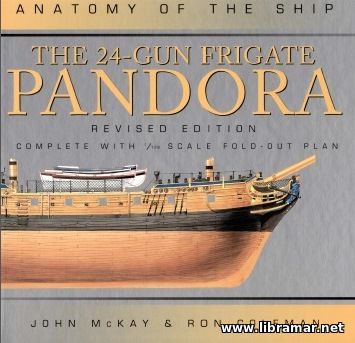 One more pearl of the Conway's Anatomy of the Ship series. In their book John McKay and Ron Coleman joined their efforts to familiarize readers with the world famous frigate Pandora. The book is pretty full of the very valuable info related to the design and newbuilding process, construction of the ship - in particular, hull construction, copper sheathing and fastening, pumps, armament, galley stove and still, boats, decoration, sweeps, oars, steering system, anchors and cables, yards, masts and rigging.
There are so many detailed technical drawings, sketches and even paint schemes depicting the construction of internal and external hulls of the vessel, her general arrangement, armament, fittings, masts and yards, sails and rigging, etc. It shall be noted that in the opinion of some of the reviewers of this book, it is the best and stand-out one in the whole AOTS collection.
That is not surprising, taking into consideration the completeness of the drawings, including 1/144-scaled cross-section and even isometric drawings providing full picture of the ship and making it very easy to build a model. This is a real treasure for any naval historian and model maker - in fact, to every person who likes the sea and whatever is related to it.
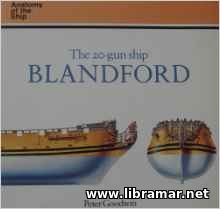 This interesting publication belongs to the world famous and popular "Anatomy of the Ship" series of books, which was released by the US Naval Institute to provide the naval history enthusiasts, ship model makers, naval architects and everyone who likes the sea and the ships, with the technical details and supporting illustrating materials relating to the construction and inner arrangement of historical vessels.
The author of this volume, Peter Goodwin, who is recognized expert, performed a thorough research work which gave a truly perfect result - his publication starts with some necessary historical info on the development of the ship, followed by technical data on the construction, decoration and general layout, steering arrangements, armament, ground tackle and pumps, standing and running rigging of the ship, sails arrangement, mats and spars, boats.
There are many photographs taken of the model and included in order to better illustrate the text. The regular and three-view drawings in the book address the general arrangement, construction of the internal and external hull, fittings, rigging, masts, boats etc., literally everything, there is no any part missed.
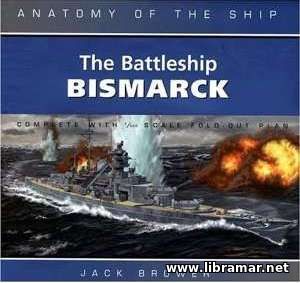 Today, we would like our readers to have a glance at the publication dedicated to the most famous warship in the naval history - the battleship Bismarck, which used to be the heaviest and biggest warship ever build in the whole European region. This nice and interesting semi-historical and semi-technical book by Jack Brower provides a pretty complete description of this vessel - the most of the publication consists of the detailed technical drawings and sketches depicting every part of the Bismarck.
The pictures provided inside to supplement the text, are very clear and truly excellent, by the way, quite rare nowadays. The plans and drawings for sure will be of great use for the marine historians, illustrators and ship model makers as well as for every person interested in the battleships of the past. This book is a really must-have for every marine history enthusiast. The book really exposes the battleship Bismarck; we have to say that, in fact, most of the information collected by the author on Bismarck, would also apply to her sister-ship, Tirpitz. The materials provided on the 160 pages of this publication will definitely be highly welcome and appreciated by any naval historian and ship modeler.
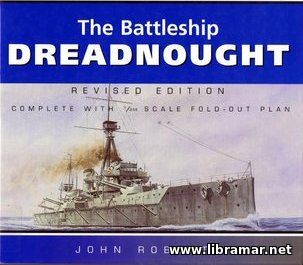 On 10 February 1906 the hull of the first all-big-gun battleship, HMS Dreadnought, was launched at Portsmouth Dockyard. Over 6000 tons of material had been built into her since her laying down just nineteen weeks beforehand. Eight months later she went to sea for the first time for her preliminary steam trials and, although this did not mark her final completion, the production of a seagoing warship of 18,000 tons, and of a new type, in such a short period of time was a remarkable achievement. The speed with which she was built was the product of the need to evaluate her qualities at the earliest opportunity and, more importantly, to steal a march on foreign navies for her revolutionary design would, if successful, render existing battleship designs obsolete.
She was, indeed, a great success and marked the beginning of a new era in battleship development; she gave her name to all subsequent vessels of the type, which became known as dreadnought battleships, or simply 'dreadnoughts'. This British coup was unusual for, in theory at least, the Royal Navy, with its enormous fleet, had the most to lose from the premature obsolescence of its battleships and had a tradition of not initiating revolutionary ideas for this very reason. That this was not the case on this occasion was due to the foresight of the recently-appointed First Sea Lord, the dynamic Admiral Sir John Fisher. He knew that other countries, in particular the United States, were progressing toward the all-big-gun concept and that such a ship would be built sooner rather than later. Another consideration was the general improvement in the building times in foreign yards, particularly in Germany, which threatened to undermine Britain's ability -enjoyed throughout the 1890s - to outbuild her rivals using the superior efficiency of her shipyards.
Under these circumstances the development of a new type abroad could have seriously weakened the Royal Navy's dominant position; but if Britain took the lead it would at least provide a chance to begin rebuilding the battlefleet while others were still catching up. In fact, a substantial breathing space was obtained and Britain was to lay down a further three dreadnoughts before Germany laid down her first in June 1907. Even so, Germany was to complete thirteen against Britain's twenty by the outbreak of the War in 1914 leaving a margin of superiority well below that enjoyed in the pre-dreadnought period.
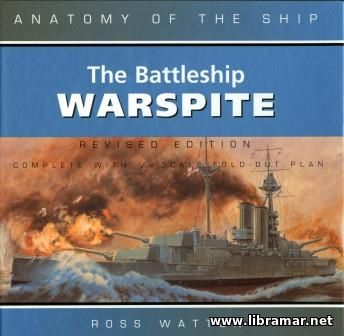 This publication by Ross Watton, who is one of the recognized experts in the field of the naval history, will tell you everything you wanted to know about the Warspite - one of the five battleships which belonged to the Queen Elizabeth class and served in the course of both first and second World Wars before they got scrapped. Those famous vessels did also participate in the historical Jutland battle.
Three major parts of this publication are named introduction, photos and technical drawings of the ship. The intro part provides some basic knowledge on the history of the construction and service. The readers will find all data they need and there is definitely not any other book of this kind that could provide them with such detailed information, from aft to boom, room-to-room, deck-by-deck.
The particular attention has been paid by the author to the hull fittings and deck machinery, fire control arrangements, armament and disruptive camouflage items, boats, ground tackle; accommodation area has always been dealt with. Have a look into this book and you will not be disappointed - it is really worth being included in your collection since the book is dedicated to the very important ship with the interesting history and excellent record of service.
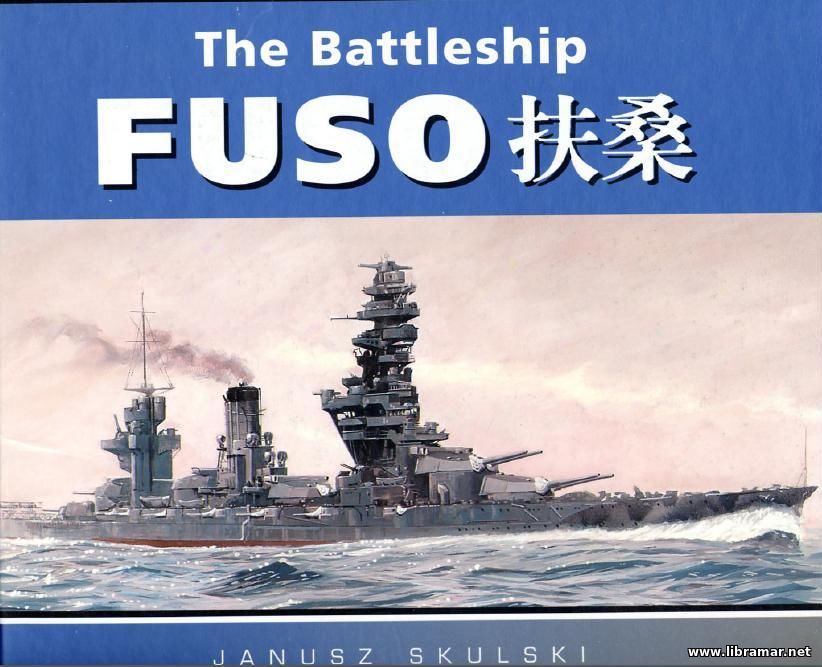 Before the famous A64-coded super-dreadnought battleship project has even been commenced, a big team consisting of the Imperial Navy naval architects visited Britain in order to assist in the building of the new Japanese battle cruiser Kongo being built at the famous Vickers ship construction yard.
They offered all their shipbuilding expertise and technical skills to a British battle-cruiser project - it was based on the Lion class ships. The truly high importance and high value of the Japanese contribution to the British project was clearly significant, for the British ship designers and naval architects adopted many of the features of the Kongo ship in the battle-cruiser Tiger.
The exchange of design knowledge worked both ways: the Japanese ship builders who went on to design the Fuso class battleships had gained full access to the very latest British project studies. However, instead of simply copying everything what they had observed during their trip to Great Britain, these specialists preferred to develop their own battleships that were to be superior to all contemporary vessels. This determination is the primary subject of the book presented to your attention...
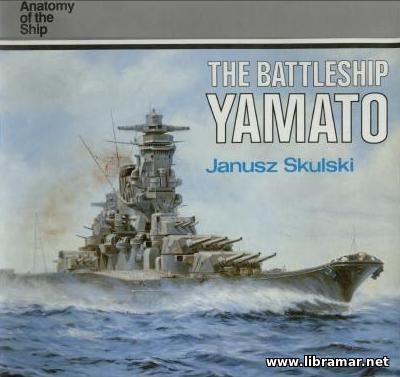 This work by Janusz Skulski provides the reader with all necessary info and interesting details of the Yamato ship. Many years ago, during the WW II, Yamato definitely proved to be a really formidable and serious opponent to any ship of the United States Navy Fleet based in the Pacific, being equipped with the heaviest armour of that time and largest 46cm guns, and having - just imagine - the greatest displacement ever.
The book contains full descriptions of the construction and design of this vessel, covering all wartime modifications made to the ship - it contains hundreds of detailed drawings, diagrams and photos supplementing the text part and technical information - they were all included by the author with the intention to impress any model maker, naval historian and, in fact, any person interested in ships of the past. We all consider this publication a detailed tribute to one of the most remarkable and legendary vessels in the naval history.
It is a must-have source for people interesting with this ship from a modeling as well as engineering and even historical perspective because of the amount and quality of the reference material contained inside. The views included in the book are rare and quite difficult to find.
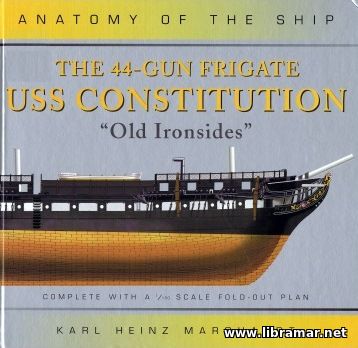 Another part of the Anatomy of the Ship collection - this one was prepared by Karl Heinz Marquardt with the intention to provide the enthusiasts of the naval history with the useful and interesting information on the USS Constitution. The ship in question is one of the six original frigates that served in the United States Navy Fleet and were ordered as a counter-measure to the Barbary corsairs.
These vessels were very fast and were heavily armed and their service was truly remarkable. The book contains all necessary technical specifications, drawings and images, giving the data on the ship's parts including hull, machinery, outfitting and armament. It will also be useful to ship modelers who may wish to build their own model of the USS Constitution as they will find all required technical data in the book. Though at the first glance this book looks as the modeler's guide, it will be everything to even to people ignorant to model making.
We recommend it to everyone willing to possess the detailed construction plans of this truly magnificent vessel in his collection. It will be equally interesting to the naval historians, nautical experts, ship model builders, and any other sort of enthusiasts.
|







